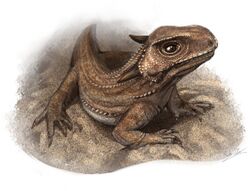Biology:Procolophonidae
| Procolophonids | |
|---|---|

| |

| |
| Skeleton (top) and life restoration (bottom) of Kapes bentoni (Procolophoninae) scale bar = 1cm | |
| Scientific classification | |
| Domain: | Eukaryota |
| Kingdom: | Animalia |
| Phylum: | Chordata |
| Class: | Reptilia |
| Clade: | †Parareptilia |
| Order: | †Procolophonomorpha |
| Superfamily: | †Procolophonoidea |
| Family: | †Procolophonidae Seeley, 1888 |
| Subgroups and Genera | |
| |
| Synonyms | |

Procolophonidae is an extinct family of small, lizard-like parareptiles known from the Late Permian to Late Triassic that were distributed across Pangaea, having been reported from Europe, North America, China, South Africa, South America, Antarctica and Australia. The most primitive procolophonids were likely insectiovous or omnivorous, more derived members of the clade developed bicusped molars, and were likely herbivorous feeding on high fiber vegetation or durophagous omnivores.[3] Many members of the group are noted for spines projecting from the quadratojugal bone of the skull, which likely served a defensive purpose as well as possibly also for display.[4] At least some taxa were likely fossorial burrowers.[5] While diverse during the Early and Middle Triassic, they had very low diversity during the Late Triassic, and were extinct by the beginning of the Jurassic.[6]
Phylogeny
Below is a cladogram from Ruta et al. (2011):[7]
| Procolophonidae |
| |||||||||||||||||||||||||||||||||||||||||||||||||||||||||||||||||||||||||||||||||||||||||||||||||||||||||||||||||||||||||||||||||||||||
References
- ↑ Cisneros, J. C. (2008). "Phylogenetic relationships of procolophonid parareptiles with remarks on their geological record". Journal of Systematic Palaeontology 6 (3): 345–366. doi:10.1017/S1477201907002350. Bibcode: 2008JSPal...6..345C.
- ↑ Hans-Dieter Sues and Robert R. Reisz (2008). "Anatomy and Phylogenetic Relationships of Sclerosaurus armatus (Amniota: Parareptilia) from the Buntsandstein (Triassic) of Europe". Journal of Vertebrate Paleontology 28 (4): 1031–1042. doi:10.1671/0272-4634-28.4.1031. Bibcode: 2008JVPal..28.1031S.
- ↑ Pinheiro, Felipe L.; Silva-Neves, Eduardo; Da-Rosa, Átila A. S. (August 2021). Ruta, Marcello. ed. "An early-diverging procolophonid from the lowermost Triassic of South America and the origins of herbivory in Procolophonoidea" (in en). Papers in Palaeontology 7 (3): 1601–1612. doi:10.1002/spp2.1355. ISSN 2056-2799. Bibcode: 2021PPal....7.1601P. https://onlinelibrary.wiley.com/doi/10.1002/spp2.1355.
- ↑ Zaher, Marta; Coram, Robert A.; Benton, Michael J. (February 2019). Angielczyk, Kenneth. ed. "The Middle Triassic procolophonid Kapes bentoni : computed tomography of the skull and skeleton" (in en). Papers in Palaeontology 5 (1): 111–138. doi:10.1002/spp2.1232. Bibcode: 2019PPal....5..111Z.
- ↑ Botha-Brink, Jennifer; Smith, Roger Malcolm Harris (September 2012). "Palaeobiology of Triassic procolophonids, inferred from bone microstructure" (in en). Comptes Rendus Palevol 11 (6): 419–433. doi:10.1016/j.crpv.2012.03.002. Bibcode: 2012CRPal..11..419B. https://linkinghub.elsevier.com/retrieve/pii/S1631068312000735.
- ↑ MacDougall, Mark J.; Brocklehurst, Neil; Fröbisch, Jörg (2019-03-20). "Species richness and disparity of parareptiles across the end-Permian mass extinction". Proceedings of the Royal Society B: Biological Sciences 286 (1899): 20182572. doi:10.1098/rspb.2018.2572. ISSN 0962-8452. PMID 30890099. PMC 6452079. http://dx.doi.org/10.1098/rspb.2018.2572.
- ↑ Ruta, M.; Cisneros, J. C.; Liebrecht, T.; Tsuji, L. A.; Müller, J. (2011). "Amniotes through major biological crises: Faunal turnover among Parareptiles and the end-Permian mass extinction". Palaeontology 54 (5): 1117–1137. doi:10.1111/j.1475-4983.2011.01051.x. Bibcode: 2011Palgy..54.1117R.
Sources
- Lambert, David (2001). Dinosaur Encyclopedia. New York: Dorling Kindersley. p. 72. ISBN 9780789479358. https://archive.org/details/dinosaurencyclop00lamb.
External links
Wikidata ☰ Q133347 entry
 |

